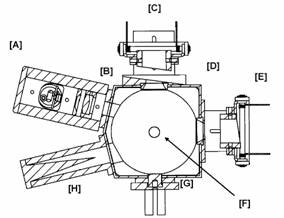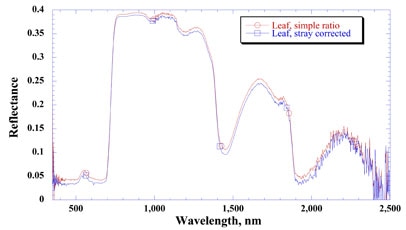Integrating spheres gather reflected light from samples over a complete hemisphere. The sphere, by nature of its internal diffuse (Lambertian) reflection and integration of the energy, is insensitive to directional reflectance characteristics coming from the sample, and thus, offers a very repeatable “averaged” response to the reflectance of the sample positioned in the beam at the sphere port.
Sample placement and incidence beam/collection alignment are less critical to the measurement results because the integrating sphere looks at representative averaged energy from all angles at the same time.
The RTS-3ZC Integrating Sphere has a 13º/D geometry to allow near normal incidence at 13º, and diffuse collection via the instrument’s fiber optic bundle. The interior of the integrating sphere is composed of Zenith diffuse polymer material, a solid, machined form of PTFE. Zenith® is a highly reflective (>95%) and Lambertian reflector over the wide spectral range of 350-2500 nm, which offers highest efficiency and optical performance.
A specially designed collimated tungsten light source, included with the sphere, delivers nearly solar irradiance levels at the sample.

The base sphere assembly has six ports engineered to accept supplied sample holders, fiber optic adapter, light trap, light source assembly, and port plugs. Two nominal 99% Zenith® diffuse reference standards, one calibrated and one uncalibrated, are included with the assembly for relative or absolute spectral reflectance measurements.

Reflectance spectrum of a leaf with (blue curve, squares) and without (red curve, circles) stray light correction.
Configurable in many different ways, with very little set up, the sphere allows for quick analysis of several important quantities:
- 13º/D Total Hemispherical Reflectance (Specular Included)
- 13º/D Hemispherical (Specular Excluded) Reflectance Factor
- Comparison Technique and Substitution Technique
- Normal Hemispherical Transmittance
The sphere can also be easily mounted on a tripod or hand carried. The RTS-3ZC Integrating Sphere is packaged in a sturdy, water-tight field portable carrying case, which holds the sphere assembly and all components tightly.
Use of Integrating Spheres in Field Radiometry
Radiation balance and plant canopy modeling studies frequently require measurement of hemispherical reflectance and transmittance values of real world samples. For many of these studies, the application of reflectance values measured using directional illumination/directional viewing geometries can result in erroneous results.
The integrating sphere is perfectly suited for these measurements as it gathers all the radiation reflected from, or transmitted through, a sample. With an external integrating sphere (sample is external to the sphere) the sphere gathers reflected light from a sample, or light transmitted through a sample, and spreads the energy over the whole surface area of the sphere in a very even distribution.
A detector then responds to a portion of the sphere wall energy to derive a significant value about the average hemispherical reflectance of the sample. Using the principles of an integrating sphere, the reflectance or transmittance of a sample can be derived using the ratio between an unknown sample and a known reference.
Spheres have been used in this manner since the beginning of the twentieth century, and techniques for measuring reflectance with spheres are well documented within US and International standards committees. In fact, if calibrated standards with known reflectance values are used as references to the sample measurements, the results can also be said to be absolutely traceable reflectance values.